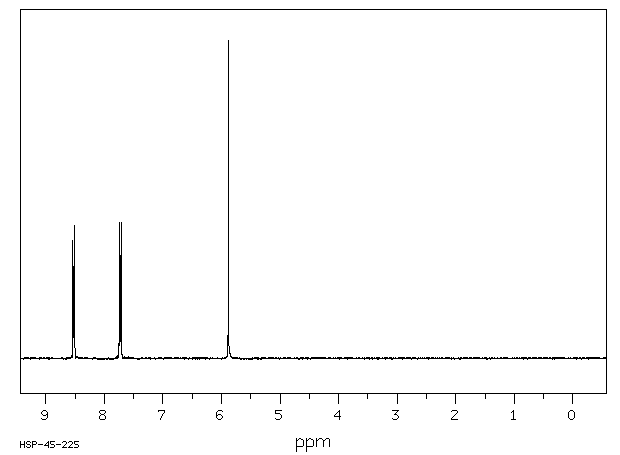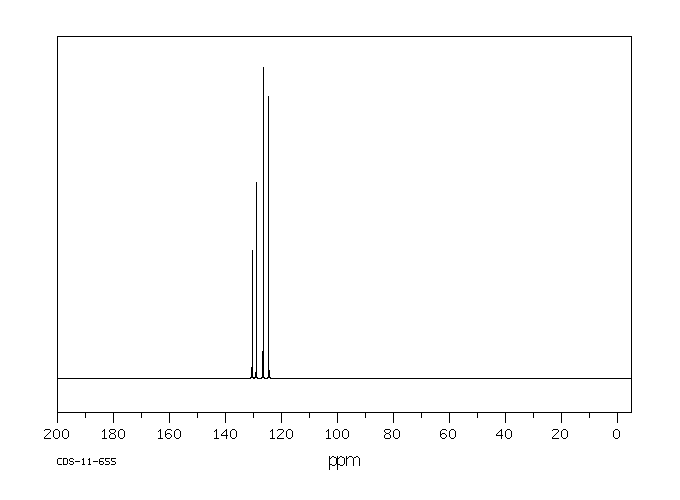9,10-二(氯甲基)蒽 | 10387-13-0
-
物化性质
-
计算性质
-
ADMET
-
安全信息
-
SDS
-
制备方法与用途
-
上下游信息
-
文献信息
-
表征谱图
-
同类化合物
-
相关功能分类
-
相关结构分类
物化性质
-
熔点:258-260°C
-
沸点:355.58°C (rough estimate)
-
密度:1.1151 (rough estimate)
-
溶解度:在热甲苯中有非常微弱的浑浊
-
稳定性/保质期:
遵照规格使用和储存,则不会分解。
计算性质
-
辛醇/水分配系数(LogP):5.7
-
重原子数:18
-
可旋转键数:2
-
环数:3.0
-
sp3杂化的碳原子比例:0.125
-
拓扑面积:0
-
氢给体数:0
-
氢受体数:0
安全信息
-
危险等级:8
-
安全说明:S26,S36/37/39
-
危险类别码:R36/37/38
-
危险品运输编号:3261
-
RTECS号:CA9365000
-
海关编码:2903999090
-
包装等级:II
-
危险类别:8
-
储存条件:请将密封于阴凉干燥处。
SDS
模块 1. 化学品
产品名称: 9,10-Bis(chloromethyl)aNThracene
修改号码: 5
模块 2. 危险性概述
GHS分类
物理性危害
金属腐蚀性 第1级
健康危害
急性毒性(经口) 第4级
急性毒性(经皮) 第4级
急性毒性(吸入) 第4级
皮肤腐蚀/刺激 1B类
严重损伤/刺激眼睛 第1级
环境危害 未分类
GHS标签元素
图标或危害标志
信号词 危险
危险描述 可能腐蚀金属
吸入或皮肤接触或吞咽有害。
造成严重的皮肤灼伤和眼损伤
防范说明
[预防] 只可存放于原用的容器内。
切勿吸入。
只能在室外或通风良好的环境下使用。
使用本产品时切勿吃东西,喝水或吸烟。
处理后要彻底清洗双手。
穿戴防护手套/护目镜/防护面具。
9,10-双(氯甲基)蒽 修改号码:5
模块 2. 危险性概述
[急救措施] 吸入:将受害者移到新鲜空气处,在呼吸舒适的地方保持休息。若感不适,呼叫解毒
中心/医生。
食入:漱口。切勿催吐。
眼睛接触:用水小心清洗几分钟。如果方便,易操作,摘除隐形眼镜。继续冲洗。
皮肤接触:立即去除/脱掉所有被污染的衣物。用水清洗皮肤/淋浴。
被污染的衣物清洗后方可重新使用。
立即呼叫解毒中心/医生。
吸收溢出物,防止材料被损坏。
[储存] 存放处须加锁。
[废弃处置] 根据当地政府规定把物品/容器交与工业废弃处理机构。
模块 3. 成分/组成信息
单一物质/混和物 单一物质
化学名(中文名): 9,10-双(氯甲基)蒽
百分比: >97.0%(GC)
CAS编码: 10387-13-0
分子式: C16H12Cl2
模块 4. 急救措施
吸入: 将受害者移到新鲜空气处,保持呼吸通畅,休息。立即呼叫解毒中心/医生。
皮肤接触: 立即去除/脱掉所有被污染的衣物。用大量肥皂和水轻轻洗。
立即呼叫解毒中心/医生。
眼睛接触: 用水小心清洗几分钟。如果方便,易操作,摘除隐形眼镜。继续清洗。
立即呼叫解毒中心/医生。
食入: 立即呼叫解毒中心/医生。漱口。切勿引吐。
紧急救助者的防护: 救援者需要穿戴个人防护用品,比如橡胶手套和气密性护目镜。
模块 5. 消防措施
合适的灭火剂: 干粉,泡沫,雾状水,二氧化碳
特殊危险性: 小心,燃烧或高温下可能分解产生毒烟。
特定方法: 从上风处灭火,根据周围环境选择合适的灭火方法。
非相关人员应该撤离至安全地方。
周围一旦着火:如果安全,移去可移动容器。
消防员的特殊防护用具: 灭火时,一定要穿戴个人防护用品。
模块 6. 泄漏应急处理
个人防护措施,防护用具, 使用特殊的个人防护用品(针对有毒颗粒的P3过滤式空气呼吸器)。远离溢出物/泄露
紧急措施: 处并处在上风处。
泄露区应该用安全带等圈起来,控制非相关人员进入。
环保措施: 防止进入下水道。
控制和清洗的方法和材料: 清扫收集粉尘,封入密闭容器。注意切勿分散。附着物或收集物应该立即根据合适的
法律法规处置。
模块 7. 操作处置与储存
处理
技术措施: 在通风良好处进行处理。穿戴合适的防护用具。防止粉尘扩散。处理后彻底清洗双手
和脸。
注意事项: 如果可能,使用封闭系统。如果粉尘或浮质产生,使用局部排气。
操作处置注意事项: 避免接触皮肤、眼睛和衣物。
9,10-双(氯甲基)蒽 修改号码:5
模块 7. 操作处置与储存
使用耐腐蚀设备。
贮存
储存条件: 保持容器密闭。存放于凉爽、阴暗处。
存放处须加锁。
远离不相容的材料比如氧化剂存放。
包装材料: 依据法律。只可存放在原用的容器內。
模块 8. 接触控制和个体防护
工程控制: 尽可能安装封闭体系或局部排风系统。同时安装淋浴器和洗眼器。
个人防护用品
呼吸系统防护: 防尘面具,自携式呼吸器(SCBA),供气呼吸器等。使用通过政府标准的呼吸器。依
据当地和政府法规。
手部防护: 防渗手套。
眼睛防护: 护目镜。如果情况需要,佩戴面具。
皮肤和身体防护: 防渗防护服。如果情况需要,穿戴防护靴。
模块 9. 理化特性
固体
外形(20°C):
外观: 晶体-粉末
颜色: 浅黄色-红黄色
气味: 无资料
pH: 无数据资料
熔点: 无资料
沸点/沸程 无资料
闪点: 无资料
爆炸特性
爆炸下限: 无资料
爆炸上限: 无资料
密度: 无资料
溶解度:
[水] 无资料
[其他溶剂] 无资料
模块 10. 稳定性和反应性
化学稳定性: 一般情况下稳定。
危险反应的可能性: 未报道特殊反应性。
须避免接触的物质 氧化剂, 碱
危险的分解产物: 一氧化碳, 二氧化碳, 氯化氢
模块 11. 毒理学信息
急性毒性: orl-rat LD50:2000 mg/kg
ivn-mus LD50:56 mg/kg
对皮肤腐蚀或刺激: 无资料
对眼睛严重损害或刺激: 无资料
生殖细胞变异原性: mmo-sat 100 ng/plate (-S9)
致癌性: ivn-mus TDLo:1100 ug/kg
IARC = 无资料
NTP = 无资料
生殖毒性: 无资料
RTECS 号码: CA9365000
9,10-双(氯甲基)蒽 修改号码:5
模块 12. 生态学信息
生态毒性:
鱼类: 无资料
甲壳类: 无资料
藻类: 无资料
残留性 / 降解性: 无资料
潜在生物累积 (BCF): 无资料
土壤中移动性
log水分配系数: 无资料
土壤吸收系数 (Koc): 无资料
亨利定律 无资料
constaNT(PaM3/mol):
模块 13. 废弃处置
如果可能,回收处理。请咨询当地管理部门。建议在可燃溶剂中溶解混合,在装有后燃和洗涤装置的化学焚烧炉中
焚烧。废弃处置时请遵守国家、地区和当地的所有法规。
模块 14. 运输信息
联合国分类: 第8类 腐蚀品
UN编号: 3261
正式运输名称: 腐蚀性固体, 酸性的, 有机的, 不另作详细说明
包装等级: II
模块 15. 法规信息
《危险化学品安全管理条例》(2002年1月26日国务院发布,2011年2月16日修订): 针对危险化学品的安全使用、
生产、储存、运输、装卸等方面均作了相应的规定。
模块16 - 其他信息
N/A
制备方法与用途
上下游信息
-
下游产品
中文名称 英文名称 CAS号 化学式 分子量 9,10-二甲基蒽 9,10-dimethylanthracene 781-43-1 C16H14 206.287 9,10-二甲酰基蒽 9,10-diformylanthracene 7044-91-9 C16H10O2 234.254 —— 9,10-bis(hydroxymethyl)anthracene 10273-85-5 C16H14O2 238.286 9,10-蒽双(甲胺) 9,10-bis(aminomethyl)anthracene 6705-67-5 C16H16N2 236.316 —— 9,10-bis(mercaptomethyl)anthracene 59045-59-9 C16H14S2 270.419 9,10-二(溴甲基)蒽 9,10-dibromomethylanthracene 34373-96-1 C16H12Br2 364.079 —— 9,10-bis(cyanomethyl)anthracene 62806-30-8 C18H12N2 256.307 9,10-二甲氧基甲基蒽 9,10-bis(methoxymethyl)anthracene 32449-02-8 C18H18O2 266.34 —— 9,10-bis(hydroxyethyl)anthracene 72898-48-7 C18H18O2 266.34
反应信息
-
作为反应物:描述:9,10-二(氯甲基)蒽 在 sodium azide 作用下, 以 N,N-二甲基甲酰胺 为溶剂, 反应 24.0h, 以93%的产率得到9,10-bis(azidomethyl)anthracene参考文献:名称:通过SCSC模式下的环烃吸附可调节的层间距离摘要:Cd(NO 3)2与新的C 2对称多齿N供体配体N,N '-(((1,1'-(蒽-9,10-diylbis(methyl))bis)bis(1)的自组装H -1,2,3-三唑-4,1-二基)双(亚甲基)双(1-(吡啶-3-基)-N-(吡啶-3-基甲基)甲胺)(L),得到生成二维(2D)框架(sql)的晶体,4C 4 H 8 O 2 @ [Cd(NO 3)2L],其中可用的层间开放空间被溶剂化的1,4-二恶烷分子占据。2D骨架之间的层间距离可以通过单晶至单晶模式下各种环烃的吸附来调节。在这种模式下,在本研究中,用1,4-二恶烷溶剂化物分子代替了苯,1,4-二恶烷,苯甲醚,反式十氢化萘,1,4-苯并二恶烷和1,5-环辛二烯的吸附。此外,该晶体体系可用作有效且宽容的晶体基质,可用于测定多种环烃的分子结构。DOI:10.1021/acs.cgd.0c01680
-
作为产物:参考文献:名称:杂原子辅助聚集诱导的增强发射(AIEE)化合物的溶剂变色,可逆色差和自组装效应摘要:合成并研究了两种化合物,9,10-双[2-(喹啉基)乙烯基]蒽(BQVA)和9,10-双[2-(萘-2-基)乙烯基]蒽(BNVA)。它们都具有聚集诱导的增强发射(AIEE)特性。杂原子辅助的BQVA表现出溶剂变色,可逆的变色性质和自组装效应。当增加溶剂极性时,BQVA的绿色溶液变为橙色,荧光发射波长从λ = 527到565 nm发生红移。值得注意的是,BQVA具有可逆的色差特性,包括机械色差和热色差。所制备的粉末BQVA显示绿色荧光(λ EM = 525纳米)和颜色可以变成橙(λ EM= 573nm)。有趣的是,橙色可以在高温下返回。基于这些可逆的色度特性,设计了一种简单方便的可擦除板。与BQVA不同,非杂原子辅助的BNVA没有清晰的发色过程。X射线衍射,差示扫描量热法,单晶分析和理论计算得出的结果表明,铬化过程取决于BQVA中的杂原子。此外,BQVA在不同溶剂中也表现出出色的自组装效果。DOI:10.1002/chem.201501902
-
作为试剂:描述:2-((1,1'-biphenyl)-3-yl)-9-(chloromethyl)acridine 在 9,10-二(氯甲基)蒽 、 sodium 作用下, 以 二甲基亚砜 、 乙醇 为溶剂, 反应 3.5h, 以47%的产率得到2-((1,1'biphenyl)-3-yl)acridine-9-carbaldehyde参考文献:名称:一种吖啶化合物及其有机发光器件摘要:本发明公开了一种含吖啶化合物及其有机发光器件。本发明的吖啶化合物具有高的发光效率,高的发光效率表明该化合物可作为电子传输材料或发光主体材料,尤其是可以作为磷光绿色主体材料,应用在有机电子发光器件中,其制造成本较低,延长了有机电子发光器件的寿命,降低了有机电子发光器件的制造成本。公开号:CN107162974A
文献信息
-
The Formation of Fluorescent Alkaline Earth Complexes by 4-{2-[10-(2-Morpholinoethyl)-9-anthryl]methyl}morpholine and its -Ethyl}morpholine and -Propyl}morpholine Analogues in Acetonitrile作者:Jason P. Geue、Nicholas J. Head、A. David Ward、Stephen F. LincolnDOI:10.1071/ch02231日期:——
The formation of fluorescent alkaline earth complexes of 4-2-[10-(2-morpholinoethyl)9-anthryl]methyl}morpholine and its new -ethyl}morpholine and -propyl}morpholine analogues, L = (1)–(3), in acetonitrile is reported. Each L has a ‘fluorophore–spacer–receptor’ structure in the sequence ‘anthracene–(methylene)n–morpholine’ in which quenching of the anthracene fluorophore becomes less effective as the receptor tertiary nitrogen becomes more distant with an increase in n from 1 to 3. Complexation by the alkaline earths (M2+) modulates photoinduced electron transfer (PET) and enhances the fluorescence of (1)–(3). The two alkyl morpholine receptors of (1)–(3) may either complex M2+ singly to form [ML]2+ and [M2L]4+ or cooperatively to form a [ML′]2+ ‘sandwich’ complex depending on the length of the alkyl spacer. Thus, (1) dominantly forms [ML]2+ and [ML′]2+ while (2) and (3) form all three complexes as exemplified by [Mg(2)]2+ and [Mg(2)′]2+ characterized by the overall complexation constant K1 = 9.19 × 104 dm3 mol−1 and [Mg2(2)]4+ characterized by the stepwise complexation constant K2 = 1.19 × 103 dm3 mol−1 at 298.2 K and I = 0.05 mol dm−3 (NEt4ClO4). The most stable and fluorescent complexes are formed by Mg2+ and Ca2+, consistent with M2+ size being an important factor affecting complex characteristics. Eighteen complexation constants and quantum yields are reported for the (1)–(3) complexes together with those for (1)–(3) alone. In 40 : 60 (v/v) 1,4-dioxan/water, protonation modulates PET to increase the fluorescence of (1)H22+–(3)H22+. (The pKa values for (2)H22+ are 6.38 and 5.62, and for (3)H22+ are 7.00 and 6.25.) The syntheses of (2) and (3) are reported.
据报道,4-2-[10-(2-吗啉基乙基)9-蒽基]甲基}吗啉及其新的-乙基}吗啉和-丙基}吗啉类似物 L = (1)-(3) 在乙腈中形成了荧光碱土络合物。每种 L 都具有 "蒽-(亚甲基)n-吗啉 "序列中的 "荧光团-间隔物-受体 "结构,其中随着 n 从 1 增加到 3,受体叔氮的距离越来越远,蒽荧光团的淬灭效果也越来越差。 碱土(M2+)的络合调节了光诱导电子转移(PET),并增强了 (1)-(3) 的荧光。(1)-(3)的两个烷基吗啉受体可以单独络合 M2+,形成[ML]2+ 和[M2L]4+,也可以根据烷基间隔的长度合作形成[ML′]2+"三明治 "复合物。因此,(1)主要形成[ML]2+和[ML′]2+,而(2)和(3)则形成所有三种络合物,例如[Mg(2)]2+和[Mg(2)′]2+,其特点是总体络合常数 K1 = 9.在 298.2 K 和 I = 0.05 mol dm-3 (NEt4ClO4) 条件下,[Mg2(2)]4+ 的阶跃络合常数 K2 = 1.19 × 103 dm3 mol-1。Mg2+ 和 Ca2+ 形成的复合物最稳定、荧光最强,这说明 M2+ 的大小是影响复合物特性的一个重要因素。报告了 (1)-(3) 复合物的 18 个络合常数和量子产率,以及 (1)-(3) 复合物本身的络合常数和量子产率。在 40 : 60 (v/v) 1,4-二氧六环/水中,质子化作用会调节 PET,从而增加 (1)H22+-(3)H22+ 的荧光。(2)H22+ 的 pKa 值分别为 6.38 和 5.62,(3)H22+ 的 pKa 值分别为 7.00 和 6.25)。报告了 (2) 和 (3) 的合成过程。 -
用于肝素检测和pH响应的AIE荧光探针、合成方法以及应用
-
Synthesis, photophysical and electrochemical properties of a new class of fluorescent amidoanthracenophanes作者:Ayyavoo Kannan、Perumal RajakumarDOI:10.1039/c5ra14357h日期:——Fluorescent amidoanthracenophanes 1, 2, 3 and 4 were obtained from the various aromatic diacid chlorides and diamino precyclophane by simple acylation. All the synthesized amidoanthracenophanes 1, 2, 3 and 4 show three intense fluorescence bands between 401 and 402, 426 and 429, and at 449 to 451 nm, and exhibit two/three oxidation reduction peaks in the cyclic voltammetry which is characteristic of
-
Orchestrating Directional Molecular Motions: Kinetically Controlled Supramolecular Pathways of a Helical Host on Rodlike Guests作者:Xiang Wang、Barbara Wicher、Yann Ferrand、Ivan HucDOI:10.1021/jacs.7b04884日期:2017.7.12was designed to fold and self-assemble into a double helical host having a cylindrical cavity complementary to linear oligocarbamate guests. Formation of helical pseudorotaxane complexes, foldaxanes, between the host and guests having binding stations of different affinities was evidenced by NMR and X-ray crystallography. Rodlike guests possessing two or three binding stations, long alkyl or oligoethylene芳香族低酰胺序列被设计为折叠并自组装成双螺旋宿主,该宿主具有与线性低聚氨基甲酸酯客体互补的圆柱腔。通过NMR和X射线晶体学证明在具有不同亲和力结合位点的主体和客体之间形成螺旋假轮烷络合物,foldaxanes。杆状客体具有两个或三个结合位点,长的烷基或低聚乙二醇间隔基或在结合位点之间的笨重的屏障,以及一个末端的单个笨重的塞子。通过1监测双螺旋沿多工位杆的穿线和平移的动力学研究1 H NMR。结果表明,在宿主从杆的非本体末端滑动达到热力学最稳定的状态之前,宿主可能会发生多种事件,包括解折叠介导的解离发生时间,包括在中间位点的结合以及沿着未结合的间隔子的快速滑动。相反,安装阻止滑动的动力学屏障可将超分子轨道中的螺旋解离重结合步骤刻意整合到一起。典型的滑动过程可以在数小时的时间内进行监控,而涉及螺旋线的展开和倒卷的步骤则需要数天的时间。这些结果进一步证明了对折叠烷的兴趣,以通过调节所涉及的各个步
-
Highly selective fluorescent chemosensors for cadmium in water作者:Thorfinnur Gunnlaugsson、T. Clive Lee、Raman ParkeshDOI:10.1016/j.tet.2004.08.047日期:2004.11to typical monomeric anthracene emission, due to suppression of PET, that is, the anthracene emission was ‘switched on’. Nevertheless, in the presence of Cd(II) a broad emission centred at 500 nm was observed, similar to that seen for 1. These ion induced long wavelength emission bands were assigned to the formation of charge-transfer complexes (exciplexes) between the anthracene moieties and the ion-receptor描述了两种新型化学传感器1和2的设计,合成和光物理评估,用于选择性检测pH 7.4的水中的Cd(II)。两者均基于使用芳族亚氨基二乙酸酯受体,该受体通过共价甲基间隔基与蒽荧光团连接。这些是高度水溶性的传感器,由于受体对蒽激发态的光诱导电子转移(PET)猝灭,因此在pH值为3-11时荧光会“关闭”。然而,受体质子化后,发射被“接通”。根据这些变化,确定1和2的pK a s为1.8和2.5分别。两者都显示出对Cd(II)优于竞争性离子(如II组和Zn(II),Cu(II),Co(II))的良好选择性。对于具有单个受体的1,对于游离传感器,在pH 7.4(HEPES缓冲液,135 mM NaCl)下仅观察到弱的蒽蒽排放。Zn(II)滴定后,出现了宽红移发射,中心在468 nm。在Cd(II)存在下,也观察到了类似的红移发射,但是这次集中在506 nm处。与这些结果相反,由于抑制了PET,在Zn(
表征谱图
-
氢谱1HNMR
-
质谱MS
-
碳谱13CNMR
-
红外IR
-
拉曼Raman
-
峰位数据
-
峰位匹配
-
表征信息










